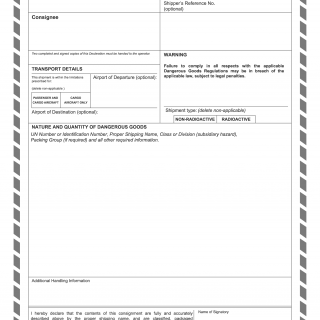IATA DGD Form. Dangerous Goods Declaration
A Dangerous Goods Declaration (DGD) is a form that is used by shippers to declare the hazardous nature of the goods being transported. The purpose of the DGD is to ensure that the hazardous goods are transported safely and in compliance with national and international regulations.
The DGD consists of several sections, including the shipper's name and address, the consignee's name and address, the description of the hazardous goods being transported, the UN number, the packing group, and the quantity of the goods. The DGD must also include the emergency response telephone number and the signature of the person responsible for preparing the declaration.
The parties involved in the DGD are the shipper, the carrier, and the receiver of the hazardous goods. It is important to consider the regulations and requirements of the country or region where the goods are being transported when completing the DGD.
When completing the DGD, the shipper will need to provide detailed information about the hazardous goods being transported, including the UN number, the proper shipping name, the hazard class, and the packing group. The shipper may also need to attach additional documents, such as a Material Safety Data Sheet (MSDS) or a Transport Emergency Card (TREC), to support the declaration.
The DGD is required for the transportation of hazardous goods by road, rail, sea, or air. It is used to ensure that the hazardous goods are transported safely and in compliance with national and international regulations. Failure to provide a DGD can result in fines, penalties, or delays in the transportation of the goods.
Strengths of the DGD include the ability to ensure the safe transportation of hazardous goods and compliance with regulations. Weaknesses include the potential for delays in the transportation of the goods and the need for accurate and detailed information to be provided.
Related forms and analogues include the Transport Emergency Card (TREC) and the Material Safety Data Sheet (MSDS). The main difference between the DGD and these other forms is the focus on the transportation of hazardous goods and the need for detailed information about the goods being transported.
The DGD can affect the future of the participants by ensuring the safe transportation of hazardous goods and compliance with regulations. The DGD is submitted to the carrier and is stored for a period of time in accordance with national and international regulations.
How to Fill out DGD Form
Filling out a Dangerous Goods Declaration (DGD) can be a complex process, as it involves providing detailed information about the dangerous goods being transported. Here is a general guide on how to fill out a DGD:
-
Identify the consignor and consignee: The consignor is the person or company that is shipping the dangerous goods, while the consignee is the person or company that is receiving them.
-
Provide a description of the dangerous goods: Include the proper shipping name, UN number, class, subsidiary risk, packing group, and any special provisions or exemptions that may apply.
-
Indicate the quantity and type of packaging: This includes the number of packages, the type of packaging (e.g. drums, boxes, cylinders), and the total weight of the dangerous goods.
-
Specify any necessary transport information: This includes the mode of transport (e.g. air, sea, road), the carrier's name and contact details, and any required emergency response information.
-
Sign and date the declaration: The person responsible for the shipment must sign and date the declaration to confirm that all the information provided is accurate and complete.
It is important to note that regulations governing the transportation of dangerous goods can vary by country and mode of transport. Therefore, it is recommended to consult with the relevant authorities in your area to ensure that you are complying with all applicable regulations.
In conclusion, the Dangerous Goods Declaration (DGD) is a form used by shippers to declare the hazardous nature of the goods being transported. It consists of several sections and requires detailed information about the hazardous goods being transported. The DGD is used to ensure the safe transportation of hazardous goods and compliance with regulations.

